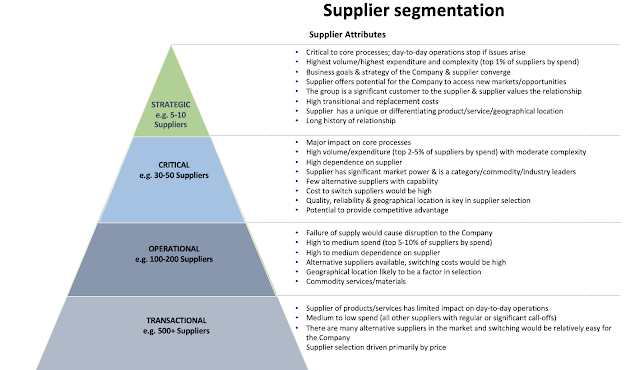The Relationship-based Supplier Segmentation Model (FORT)
The relationship-centric approach to supplier segmentation
In our earlier post, we provided a comprehensive view of the theoretical and practical aspects of outsourcing.
Recently, we came across a model to segment vendors by relationship types. It's not only sound in the context of outsourcing but may be applied to structure your supplier relationship management (SRM) strategy.
The traditional supplier segmentation model
The traditional approach to supplier segmentation as a part of the Supplier Relationship Management framework assumes the complex categorization by multiple attributes, e.g., spend volume, degree of core process dependency, risk profile, relationship maturity, and cost of replacement.
FORT (Four Outsourcing Relationship Types) Model
The FORT model (1996) considers outsourcing to manage relationships with service providers rather than a simple subcontract.
Consequently, we can construct our generic strategy and understand the intentions of our providers to move from one cell to another. The FORT model may serve as the classical Kraljic matrix used for supply base segmentation by risk and profitability.
This model segments the outsourcing companies across two dimensions: the extent of substitution by vendors (i.e., the degree of outsourcing) and the strategic impact of outsourcing services.
When substitution is low, as in Support and Alignment relationships, clients invest little in service provider-specific assets. Low asset specificity (as we learned from the Transactional Cost Economics) and the competitive market for such services means a small risk of opportunistic behavior of vendors (especially SMEs and startups in the Support cell) and a cost-reduction emphasis.
Therefore, clients establish shorter-term contracts and don't elaborate on performance incentives.
On the other hand, when the extent of substitution by service providers is great, service provider-specific investments by clients are also high. Clients become more dependent on leveraging the vendor's technology and competencies to achieve the projected business value.
This results in a locked-in relationship and an increased risk of opportunism.
A complex system of contractual incentives to reduce costs and performance penalties is required in the Reliance cell.
Meanwhile, Alliance relationships entail a high mutual trust and commitment translated into vested contracts with shared business goals. Otherwise, high asset specificity leads to applying the hierarchy governance, i.e., insourcing.
Naturally, the service provider's business strategy is to move to the Alliance cell, while the Support ones are happy to get to any other cell.
FORT Model as the supplier segmentation best practice in the SRM context
This model can be applied beyond the realms of the BPO industry. For instance, it can segment your supply base in the context of the SRM.
The extent of substitution can be extended to the dependence on suppliers.
Alliance vendors will become ones on which your company is highly dependent over a broader scope of strategic services.
Reliance vendors will provide niche services, where your company depends on them significantly, and so on.
This model could streamline SRM adoption due to its simple and intuitive nature.
P.S. This content is the most recent part of my research summarized in the Udemy course "Foundations of Contracts and Outsourcing."







Comments
Post a Comment